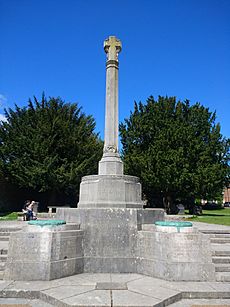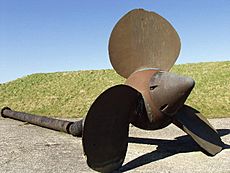HMS Hampshire (1903) facts for kids

Hampshire at anchor
|
|
Quick facts for kids History |
|
|---|---|
| Name | HMS Hampshire |
| Namesake | Hampshire |
| Builder | Armstrong Whitworth, Elswick |
| Laid down | 1 September 1902 |
| Launched | 24 September 1903 |
| Completed | 15 July 1905 |
| Fate | Sunk by mine, 5 June 1916 |
| Status | Protected war grave |
| General characteristics | |
| Class and type | Devonshire-class armoured cruiser |
| Displacement | 10,850 long tons (11,020 t) (normal) |
| Length | 473 ft 6 in (144.3 m) (o/a) |
| Beam | 68 ft 6 in (20.9 m) |
| Draught | 24 ft (7.3 m) |
| Installed power | |
| Propulsion |
|
| Speed | 22 knots (41 km/h; 25 mph) |
| Capacity | 1,033 long tons (1,050 t) coal |
| Complement | 610 |
| Armament |
|
| Armour |
|
HMS Hampshire was a powerful warship known as an armoured cruiser. She was one of six ships in her class, built for the Royal Navy in the early 1900s.
After being built, Hampshire joined the Channel Fleet. Later, she served in the Mediterranean Fleet and then the China Station. When World War I began in 1914, she was still in China.
The ship helped hunt down German ships that were attacking trade routes. She then joined the main British fleet, called the Grand Fleet. Hampshire was part of the Battle of Jutland in 1916, a huge naval battle.
Just days after this battle, Hampshire was sailing to Russia. On board was Lord Kitchener, a very important British leader. The ship hit a naval mine on June 5, 1916, and sank quickly. Many lives were lost, including Lord Kitchener.
Contents
Ship Design and Features
Hampshire was a large ship, weighing about 10,850 tons. She was about 144 meters (473 feet) long. Her width was about 20.8 meters (68 feet).
The ship was powered by two steam engines. These engines gave her a top speed of 22 knots (about 41 kilometers per hour). She carried over 1,000 tons of coal to fuel her engines. About 610 sailors and officers worked on board.
Ship's Armament
Hampshire had strong weapons for fighting. She had four large 7.5-inch guns. These were in turrets at the front, back, and sides of the ship. She also had six 6-inch guns placed along her sides.
For closer combat, she carried smaller 3-pounder guns. The ship also had two torpedo tubes. These could fire torpedoes, which are underwater missiles.
Ship's Protection
The ship was protected by thick armour. Her sides had armour up to 6 inches thick. The gun turrets and other important areas also had strong armour. This protection helped keep the ship and its crew safe during battles.
Ship's Journey and Service
Hampshire was built in England and finished in 1905. She was named after the English county of Hampshire.
She first joined the 1st Cruiser Squadron. Later, she moved to the reserve fleet. In 1911, she went to the Mediterranean Sea. In 1912, she was sent to the China Station.
World War I Service
When World War I started, Hampshire was in China. She was ordered to find and destroy a German radio station. She also helped search for German ships that were attacking British trade.
One famous German ship she hunted was the light cruiser Emden. Hampshire searched for Emden for months. Emden was eventually sunk by another ship.
After this, Hampshire helped escort troops from Australia and New Zealand to Egypt. She then returned to Britain. In 1915, she escorted ships in the White Sea.
In May 1916, Hampshire took part in the Battle of Jutland. This was a huge battle between the British and German navies. Hampshire was not directly involved in heavy fighting during this battle.
Last Voyage and Sinking
After the Battle of Jutland, Hampshire was given a special mission. She was to take Lord Kitchener to Russia. Lord Kitchener was a very important government official.
The ship left Scapa Flow in a very bad storm. The strong winds made it hard for her escort ships, two destroyers, to keep up. So, the destroyers were sent back. Hampshire continued alone.
The Mine Strike
On June 5, 1916, Hampshire was sailing near the Orkney Islands. At about 7:40 PM, a large explosion happened. The ship had hit a naval mine. This mine had been placed by a German submarine, U-75, a few days earlier.
The explosion severely damaged the ship. The rough seas made it impossible to launch the lifeboats safely. About 15 minutes after the explosion, Hampshire sank.
Loss of Life
Out of 735 crew members and 14 passengers, only 12 people survived. They managed to reach shore on rafts. Lord Kitchener and everyone on his mission to Russia were among the 737 people lost.
There were later rumours about German spies being involved in the sinking. These stories suggested sabotage, but they were never proven.
The Wreck of HMS Hampshire
The wreck of Hampshire lies upside down in about 55 to 70 meters (180 to 230 feet) of water. It is a protected site under the Protection of Military Remains Act 1986. This means diving on the wreck is not allowed without a special permit.
Memorials

In 1983, a propeller and part of the ship's drive shaft were brought up from the wreck. You can see them today at the Scapa Flow Visitor Centre and Museum in Lyness, Hoy, Orkney.
A memorial for the 737 people lost on Hampshire is located outside Winchester Cathedral.
A tower was built on Marwick Head in 1924. The people of Orkney built it to remember Lord Kitchener and all the men who died on Hampshire.
Media and Portrayals
The sinking of Hampshire and Lord Kitchener's death have been shown in films. These include the 1921 film How Kitchener Was Betrayed and the 1969 film Fraulein Doktor.
The ship also appears in the 2010 novel Crescent Dawn by Clive Cussler. In the story, the ship is destroyed by a bomb placed inside it.
Images for kids



